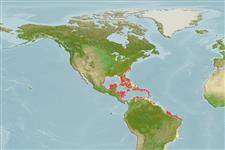>
Carangiformes (Jacks) >
Carangidae (Jacks and pompanos) > Caranginae
Etymology: Caranx: French, carangue, the name of a Caribbean fish; 1836 (Ref. 45335).
More on author: Bloch.
Environment: milieu / climate zone / depth range / distribution range
Écologie
marin récifal; océanodrome (Ref. 51243); profondeur 0 - 35 m (Ref. 40849), usually 0 - 22 m (Ref. 9710). Subtropical; 35°N - 33°N, 100°W - 33°W
Western Atlantic: New Jersey (USA), Bermuda, and Gulf of Mexico to southern Brazil; throughout the Caribbean Sea (Ref. 9626). Most common in the West Indies (Ref. 26938).
Length at first maturity / Taille / Poids / Âge
Maturity: Lm 31.0, range 26 - ? cm
Max length : 73.0 cm FL mâle / non sexé; (Ref. 6937); common length : 50.0 cm TL mâle / non sexé; (Ref. 5217); poids max. publié: 8.2 kg (Ref. 3277)
Description synthétique
Clés d'identification | Morphologie | Morphométrie
Épines dorsales (Total) : 8 - 9; Rayons mous dorsaux (Total) : 26 - 30; Épines anales: 2 - 3; Rayons mous anaux: 23 - 26.
Common in clear insular areas or in coral reefs off mainland coasts (Ref. 5217). Juveniles frequent areas with algae (e.g. Sargassum) (Ref. 26235). Usually in schools which may be spawning groups; occasionally solitary. Feeds on fishes, shrimps and other invertebrates. Marketed fresh (Ref. 56217). Easily approached (Ref. 9710). Large individuals have caused ciguatera when eaten (Ref. 13442).
Berry, F.H. and W.F. Smith-Vaniz, 1978. Carangidae. In W. Fischer (ed.) FAO species identification sheets for fishery purposes. West Atlantic (Fishing Area 31). volume 1. FAO, Rome. [var. pag.]. (Ref. 3277)
Statut dans la liste rouge de l'IUCN (Ref. 130435)
Menace pour l'homme
Reports of ciguatera poisoning (Ref. 30302)
Utilisations par l'homme
Pêcheries: commercial; pêche sportive: oui
Outils
Articles particuliers
Télécharger en XML
Sources Internet
Estimates based on models
Preferred temperature (Ref.
123201): 23.2 - 28, mean 26.8 °C (based on 420 cells).
Phylogenetic diversity index (Ref.
82804): PD
50 = 0.5000 [Uniqueness, from 0.5 = low to 2.0 = high].
Bayesian length-weight: a=0.01585 (0.01287 - 0.01951), b=2.94 (2.91 - 2.97), in cm total length, based on LWR estimates for this species (Ref.
93245).
Niveau trophique (Ref.
69278): 4.3 ±0.1 se; based on diet studies.
Generation time: 7.7 ( na - na) years. Estimated as median ln(3)/K based on 1
growth studies.
Résilience (Ref.
120179): Milieu, temps minimum de doublement de population : 1,4 à 4,4 années (K=0.14-0.24; tm=3; Fec=800,000).
Fishing Vulnerability (Ref.
59153): High vulnerability (57 of 100).
Climate Vulnerability (Ref.
125649): Very high vulnerability (84 of 100).
Nutrients (Ref.
124155): Calcium = 13.4 [5.4, 24.9] mg/100g; Iron = 0.347 [0.166, 0.748] mg/100g; Protein = 20.6 [18.2, 23.0] %; Omega3 = 0.17 [0.09, 0.32] g/100g; Selenium = 16.9 [6.9, 41.2] μg/100g; VitaminA = 62.4 [20.7, 184.8] μg/100g; Zinc = 0.341 [0.224, 0.543] mg/100g (wet weight);
